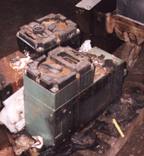How to Test a Resistance Welding Transformer
The tests described below utilize an ohmmeter. A regular unit will pick up most shorts, but a mega-ohm meter, if available, will work better. Later steps also ask you to use a fused 110 VAC power cord. Make sure the cord is fused with a ~5 amp fuse. As always, exercise due care and caution when working around live electricity.
THE FINE PRINT: T. J. Snow assumes no liability by you following these directions. You do so at your own personal risk, and at the risk of damage to your equipment. If something goes wrong, you cannot hold us liable. If you cannot accept these limitations do not proceed with these tests.

- Make sure that the power to the welder is disconnected and the power is locked-out according to plant approved lockout-tagout procedures.
- Disconnect the line leads running from the transformer or tap switches to the control.
- If the transformer has a tap switch connected to it, make sure that it is on a tap and not in the “off” position.
- Connect the ohmmeter across the line leads that you disconnected from the control. You should read zero ohms, or “continuity”, through the primary of the transformer.
- Next connect the ohmmeter between either line lead and the secondary of the transformer. You should read infinite ohms, or “no continuity”.
- Now connect the ohmmeter between either line lead and the ground (or frame) of the transformer. You should read infinite ohms, or “no continuity”.
- Turn all tap switches to their highest setting.
- Make sure that the weld tips, or secondary of the transformer is an open, not complete, circuit. This can be accomplished by placing a piece of rigid insulation or an old credit card between the tips.
- Connect the fused 110 VAC cord across the two line leads. Note: If the windings of the transformer are bad, you will probably blow the fuse in the 110V cord.
- Check the Secondary output voltage of the transformer with a voltmeter. This measurement should be made right at the transformer, and not at the tips. Bad connections in the secondary loop could cause a larger voltage drop across them. Also make sure that the secondary loop is still open (above) or the transformer will be under a load.
- If your welder has a 220 VAC supply, you should read about ½ of the rated maximum secondary voltage.
- If your welder has a 440 VAC supply, you should read about ¼ of the maximum rated secondary voltage.
- If the voltage reading is close, your transformer is probably good.
- If you have a clamp type ammeter, you can check the primary current draw of the 110V line. It should be no more than 1 to 2 amps for most transformers.
If you have any questions, feel free to call T. J. Snow’s transformer experts at (423) 894-6234.
